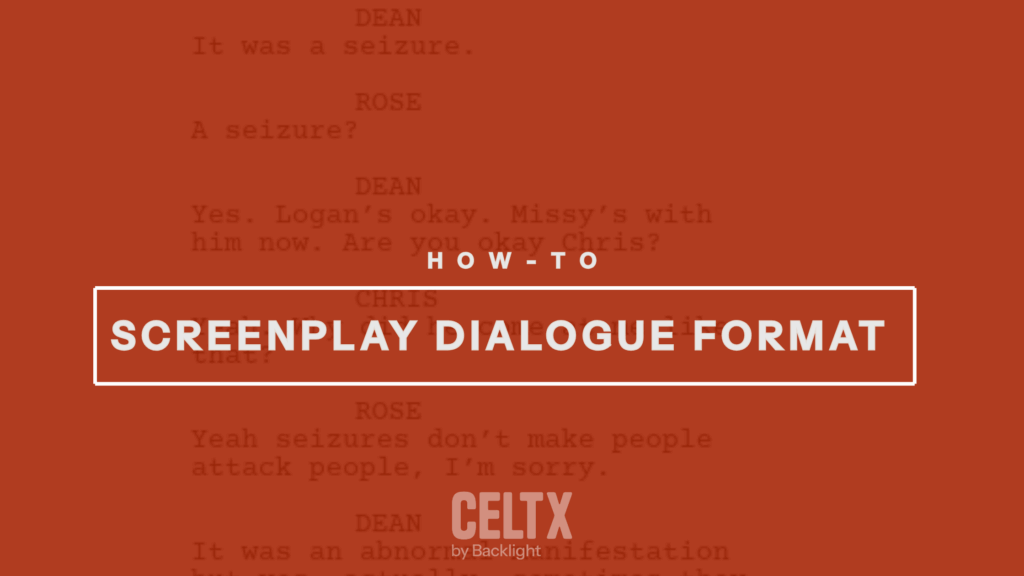
Writing dialogue for a screenplay isn’t just about capturing compelling, believable conversations, but also about presenting the words your characters speak in the right format.
Unlike a novel or short story, a screenplay is more of a technical document which directors, producers, and actors need to interpret quickly. So, it’s crucial that your dialogue is formatted correctly, otherwise you’re in danger of confusing your readers and even have your script tossed from an executive’s consideration pile.
“Dialogue is a necessary evil.” – Fred Zinneman
If you’re confused by dialogue, we’re here to demystify it all for you. In today’s blog, we’ll tick off the essential rules of formatting dialogue in a screenplay, why on Earth these rules matter, as well as exposing common mistakes to avoid! We’ll even throw in our top tips on how to write dialogue that not only reads well but looks professional on the page.
Let’s get started…

Table of Contents
- Why Proper Formatting Matters
- The Basics of Screenplay Dialogue Formatting
- Rules to Know
- Dialogue Tags and Action Lines
- Examples from Famous Scripts
- Common Mistakes to Avoid
- FAQ
- Conclusion
Why Proper Formatting Matters
The rules of screenwriting don’t exist for the sake of it, and that also goes for formatting. There are several good reasons for it, such as:
1. Industry Standards
Screenplays are part of a highly collaborative process. Directors, actors, production managers, and editors all rely on the script to convey timing, pacing, and production needs. Proper formatting ensures everyone is on the same page. Literally!
2. Readability
Well-formatted dialogue is easy to read and visually appealing. Due to this, readers are encouraged (especially busy industry professionals) to keep turning the page.
3. Timing and Pacing
Formatting affects both page count and pacing. One page of a screenplay typically equals one minute of screentime, so if your dialogue is bloated to badly structured, it will throw off the timing of a scene and even the entire script.
Want to explore script formatting in more detail? Then our comprehensive guide to formatting your screenplay is for you! Find it here.

Want to skip the formatting headaches? Celtx formats your dialogue automatically—so you can focus on what your characters are really saying.
Click here to get started!
The Basics of Screenplay Dialogue Formatting
Before we dive into the nitty gritty of the specific rules, let’s focus on the basic structure of dialogue formatting in a screenplay:
1. Indentation
Dialogue is centred on the page using industry-standard indentation.
First, the character name is positioned 3.7 inches from the left margin (or centred at 4.2 inches depending on your software)
Next, the dialogue follows on the next line, starting 2.5 inches from the left margin and ends around 6 inches from the left. This creates a narrow column that’s easy to read.
Here is an example from our sample script, The Beach:

2. Character Name
You’ll also see from the example above that the name of each character is in ALL CAPS.
Remember, make sure it matches the character’s name as introduced earlier in the script, not a nickname or variation (unless it’s intentional and already established.
3. Parentheticals
Also known as ‘wrylies’, parentheticals are optional and used sparingly to give short instructions about how the line is to be delivered. Just like this:

Rules to Know
Now we’ve covered the basics, let’s take a look at some specific situations that require precise formatting.
1. Voice Over (V.O.)
Voice over is used when a character is narrating or speaking off-screen in a non-diegetic way. For example:

You may need to use voice over when writing:
- Internal monologues
- Letters being read aloud
- Narrator’s voice
For more on how to use voice over effectively in your screenplay, check out our dedicated post here.
2. Off-Screen (O.S.) or Off-Camera (O.C.)
This is used when a character is speaking but not visible in the frame. For example:

3. Interruptions
When one character cuts another off, use a dash at the point of interruption.

Similarly, if a character’s own speech trails off or gets cut by external action, you can use ellipsis instead.

4. Dual Dialogue
When two characters speak at the same time, use side-by-side columns. Most screenwriting software like Celtx supports dual dialogue formatting.

Again, use this sparingly and make sure to use software, as dual dialogue is very tricky to manually format.
Dialogue Tags and Action Lines
While we know these aren’t technically dialogue, action lines often work in tandem with what characters say and how they say it.
Let’s see how action lines tie into dialogue.
Action Lines Before Dialogue
You can use action lines to give context to a character’s state of mind, surroundings or actions. However, you decide to use them, keep them as concise as possible. Just like this:

Dialogue Breaks with Action
If a character speaks, then acts, then speaks again, it’s a good idea to split everything into separate blocks. For example:

Examples from Famous Scripts
Now it’s time to check out how pro-screenwriters handle dialogue formatting!
1. Pulp Fiction (1994) – Quentin Tarantino
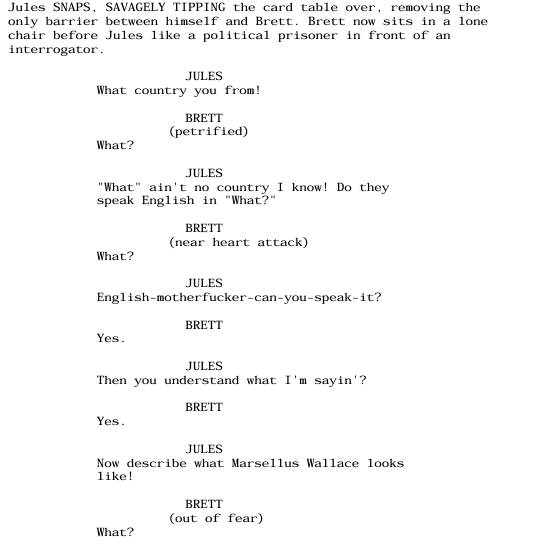
Notice Tarantino’s use of parentheticals. They’re only used when absolutely necessary, with the emotion and tone being conveyed through structure and repetition.
2. The Social Network (2010) – Aaron Sorkin
Sorkin is famous for his punchy and fast-moving dialogue, especially the ‘walk-and-talk’ dialogue phenomena. There’s no fluff, no unnecessary action or direction. It’s all in the dialogue and delivery from the actors.
“The characters are the result of two things — first, we elaborate them into fairly well-defined people through their dialogue, then they happen all over again, when the actor interprets them.” – Joel Coen
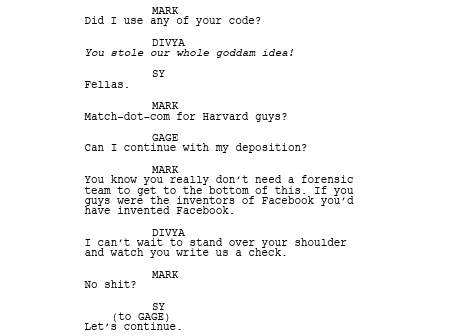
3. Moonlight (2016) – Barry Jenkins
Jenkins’ dialogue in Moonlight is simple, clear, and emotionally loaded. His formatting enhances clarity and lets the performance breathe.
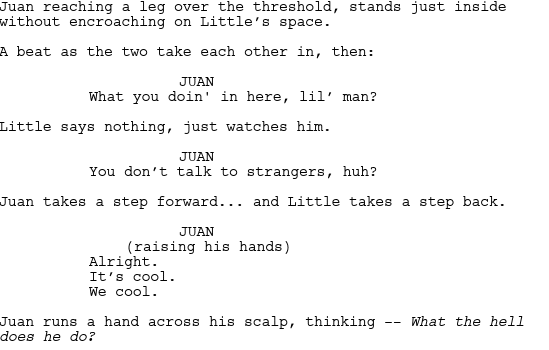
Sometimes, it’s tempting to write reams of dialogue, but you must allow subtext and action to also tell the story.
“The properties of people and the properties of character have almost nothing to do with each other. They really don’t. I know it seems like they do because we look alike, but people don’t speak in dialogue. Their lives don’t unfold in a series of scenes that form a narrative arc.” – Aaron Sorkin
4. When Harry Met Sally (1989( – Nora Ephron, Rob Reiner, Andrew Scheinman
The dialogue is well formatted in this classic from the late 1980s, with clear emotional beats written in a clean, readable block.
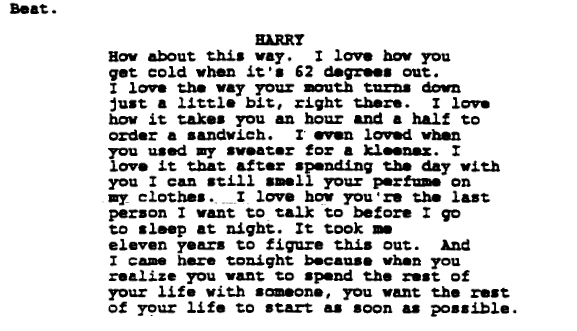
The simple formatting lets the emotional weight of the words land without interference from unnecessary parentheticals or action. While the dialogue block is longer than recommended, this is a key emotional beat of the story which has been earned.
The writing speaks for itself, allowing the audience to focus on the sentiment of Harry’s confession to Sally.
5. Good Will Hunting (1997) Matt Damon and Ben Affleck
Sean’s monologue is emotionally rich and again goes a little longer that the recommended dialogue block length. However, much like When Harry Met Sally, this moment has been earned, with Sean giving Will a much-needed pep talk.
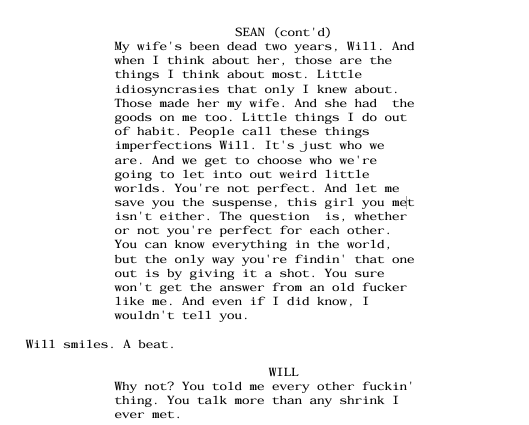
The writing remains conversational for most of the script, with the structure leaving room for the actor to interpret the dialogue in their own way.
6. Get Out (2017) – Jordan Peele
Get Out is filled with short, snappy dialogue that’s culturally loaded, blending perfectly with the overall tone and theme of the film.
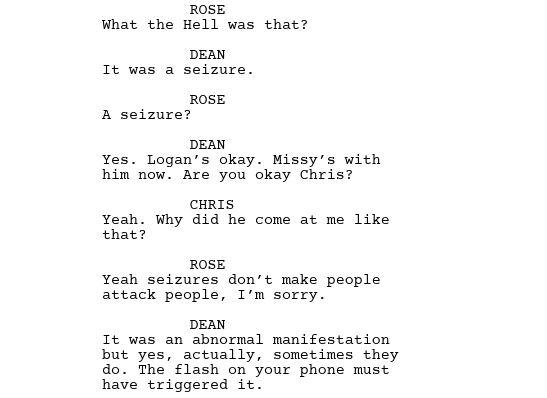
Peele hasn’t added any parentheticals or extra beats, allowing the tension and drama to come from the dialogue itself. It works extremely well both on the page and on screen.
Common Mistakes to Avoid
Even the most well-crafted dialogue can fall flat if it’s formatted incorrectly. Here are some frequent missteps to avoid:
1. Too Many Parentheticals
Yeah, we know we’ve discussed this already, but it’s too important not to mention again.
Overusing parentheticals makes dialogue feel over-directed and distracts the reader.
So, instead of:

Try this:

2. Improper Character Labels
Switching between SARAH, MOM, OR WOMAN, for the same character without consistency can confuse readers. Pick one label for each character and make sure to stick to it following their introduction.
3. Dialogue is too Dense
Each dialogue block should ideally be under four lines (much like action lines). If a character delivers a long monologue, consider breaking it up with action or another character’s reaction.
“A conversation is a dialogue, not a monologue. That’s why there are so few good conversations: due to scarcity, two intelligent talkers seldom meet.” – Truman Capote
4. Avoid Novelistic Language
Keep your dialogue and action lines as visual and cinematic as possible. Remember, your screenplay is not prose! Avoid internal thoughts, overly descriptive phrases, or abstract language.
So, instead of this:
He thinks about the past, the weight of memory on his shoulders.
Write something like this:
He stares out the window, jaw clenched. Something’s bothering him.

FAQ
What are the five rules of writing dialogue?
- Keep your dialogue natural but purposeful. Every line should serve character or story.
- Avoid exposition dumps and let information organically emerge.
- Show, don’t tell. Use subtext.
- Give your characters distinct voices. No two people should sound the same.
- Trim the fat and say more with fewer words.
How do you format a break in dialogue with action?
When a character speaks, acts, then speaks again, you could format it like this:

Can you start a script with voice over narration?
Absolutely! Many scripts do start with a voice over narrator to set the tone or backstory. Just make sure you label it correctly.
What’s the best software for formatting dialogue?
The top choices for screenwriting software include:
- Celtx (great for beginners and experienced writers)
- Final Draft (industry standard)
- WriterDuet (great for cloud-based collaboration)
- Highland (Mac only, clean and user-friendly interface)
Conclusion
Dialogue is the heartbeat of a screenplay. But even the most emotionally powerful line will fall flat if buried in poor formatting. Learning the rules of dialogue formatting isn’t just about following tradition, it’s about respecting the collaborative nature of filmmaking and presenting your work professionally.
Whether you’re writing your first spec script or polishing your tenth, mastering dialogue formatting will make your screenplay not only readable but performable. Use the right tools, study the pros, and treat formatting as an extension of your storytelling.
The best dialogue doesn’t just say something. It does something. And when formatted correctly, it becomes a tool that actors can embody, directors can envision, and readers can lose themselves in.
Get perfectly formatted dialogue with Celtx — automatically.
Start writing today!
Up Next:

10 Tips for Writing Dialogue That Feels Real
Once your formatting is locked in, it’s time to level up the words themselves—because even the best formatting can’t save wooden lines.
